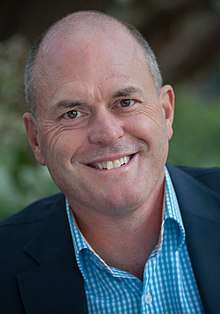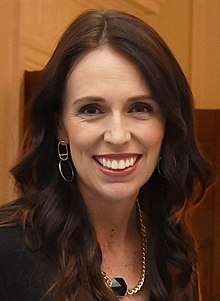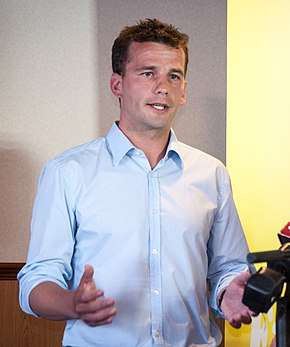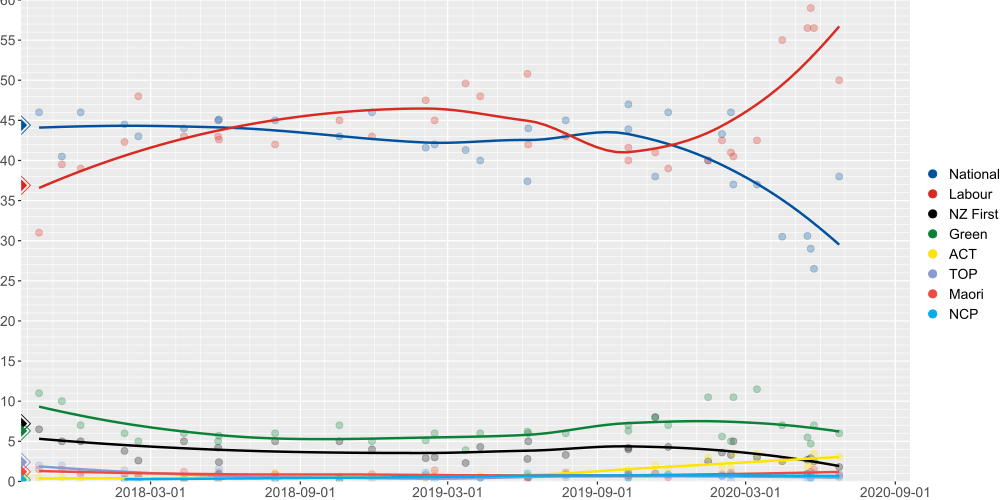2020 New Zealand general election
The 2020 New Zealand general election will be held after the currently elected 52nd New Zealand Parliament is dissolved or expires. Prime Minister Jacinda Ardern has announced the election date as Saturday 19 September 2020.[1]
| |||||||||||||||||||||||||||||||||||||||||||||||||||||||||||||
All 120 seats (plus any overhang) in the House of Representatives 61 seats needed for a majority | |||||||||||||||||||||||||||||||||||||||||||||||||||||||||||||
|---|---|---|---|---|---|---|---|---|---|---|---|---|---|---|---|---|---|---|---|---|---|---|---|---|---|---|---|---|---|---|---|---|---|---|---|---|---|---|---|---|---|---|---|---|---|---|---|---|---|---|---|---|---|---|---|---|---|---|---|---|---|
| Opinion polls | |||||||||||||||||||||||||||||||||||||||||||||||||||||||||||||
| |||||||||||||||||||||||||||||||||||||||||||||||||||||||||||||
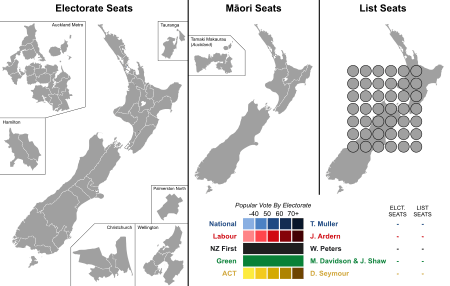 Map of the seats to be contested in the election. General electorates are shown on the left, Maori electorates in the centre, and the list seats on the right. | |||||||||||||||||||||||||||||||||||||||||||||||||||||||||||||
| |||||||||||||||||||||||||||||||||||||||||||||||||||||||||||||
Voters will elect 120 members to the House of Representatives under New Zealand's mixed-member proportional (MMP) voting system, a proportional representation system in which 72 members are elected from single-member electorates and 48 members are elected from closed party lists.
After the previous election, the centre-left Labour Party, led by Prime Minister Jacinda Ardern, formed a minority coalition government with the New Zealand First party, with confidence and supply from the Green Party. The main opponent to the Labour–NZ First government is the centre-right National Party, led by Todd Muller. The ACT Party is the sole other party in Parliament, represented by a single MP.
A referendum on personal cannabis consumption is planned to be held at the same time, along with a referendum on euthanasia held with the End of Life Choice Bill passing its third reading in parliament.[2][3]
Background
The final results of the 2017 election gave National 56 seats, while Labour and the Greens combined had 54 seats. New Zealand First won 9 seats, which put them in the position to give either National or Labour the 61 seats needed to form a government. On 19 October 2017, Winston Peters, leader of New Zealand First, announced that he would form a coalition government with Labour.[4] On the same day, James Shaw, leader of the Green Party, announced that his party would give confidence and supply to a Labour–NZ First government.[5] The result of the election saw the Labour Party regain power after nine years in opposition, as well as the end of the Fifth National Government which had been in power for three terms (2008–2017). The 2017 election also saw the first party under MMP in New Zealand to lead a government without commanding the plurality of the party vote.
On 22 May 2020, a leadership election occurred, following two low polls, in which Todd Muller replaced Simon Bridges as leader of the National Party and Leader of the Opposition, and Nikki Kaye replaced Paula Bennett as deputy leader of the party.[6]
Current standings
| Party affiliation | Seats | ||
|---|---|---|---|
| 2017 election | Current | ||
| LabourCoa | 46 | 46 | |
| NZ FirstCoa | 9 | 9 | |
| GreenCS | 8 | 8 | |
| Government total | 63 | 63 | |
| NationalInd1 | 56 | 55 | |
| ACT | 1 | 1 | |
| IndependentInd1 | 0 | 1 | |
| Opposition total | 57 | 57 | |
| Total | 120 | 120 | |
| Working Government majority | 6 | 6 | |
 | |||
| Current seating plan of Parliament | |||
- ^Coa New Zealand First announced a coalition agreement with the Labour Party on 19 October 2017.
- ^CS The Green Party entered into a confidence and supply agreement with the Labour Party on the same day as the coalition was announced.
- ^Ind1 National MP Jami-Lee Ross resigned from the party in October 2018 after an alleged leak of party documents and a public spat with then party leader Simon Bridges. He has continued to represent his electorate as an independent MP.
Electoral system
New Zealand uses the mixed-member proportional (MMP) voting system to elect the House of Representatives. Each voter gets two votes, one for a political party (the party vote) and one for a local candidate (the electorate vote). Political parties which meet the threshold (5% of the party vote or one electorate seat) receive seats in the House in proportion to the percentage of the party vote they receive. 72 of the 120 seats are filled by the MPs elected from the electorates, with the winner in each electorate determined by the first past the post method (i.e. most votes wins). The remaining 48 seats are filled by candidates from each party's closed party list. If a party wins more electorates than seats it is entitled to under the party vote, an overhang results; in this case, the House will add extra seats to cover the overhang.
The political party or party bloc with the majority of the seats in the House forms the Government. Since the introduction of MMP in 1996, no party has won enough votes to win an outright majority of seats. As a result, parties must negotiate with other parties to form a coalition government or a minority government.
Electorate boundaries
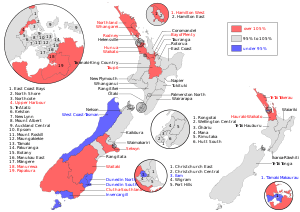
Electorate boundaries for the next election have been redrawn due to the 2018 census, so this general election will be the first to use boundaries based on that census.
The number of South Island general electorates is fixed at 16,[7] with the number of North Island general electorates and Māori electorates increasing or decreasing in proportion to the population. Each electorate must have the same population, with a tolerance of plus or minus five percent. For the 2014 and 2017 elections, there were 48 North Island general electorates and seven Māori electorates, giving a total of 71 electorates.
On 23 September 2019, Statistics New Zealand announced that there would be one additional North Island general electorate,[8] bringing the total number of North Island general electorates to 49 and the overall number of electorates to 72.[9] It also announced that 11 North Island, three South Island, and two Māori electorates were above 5% tolerance, while five South Island electorates and one Māori electorate were below 5% tolerance. The electorates most over-tolerance were Selwyn (16.5%), Papakura (14.8%), Hunua (14.2%), Rodney (14.0%) and Waitaki (11.1%).[10]
The Representation Commission undertook a review of electoral boundaries. This review was commenced in October 2019 and was completed in April 2020.[11] The boundaries will apply in the 2020 general election, and the subsequent general election. The additional electorate is located in South Auckland and is named Takanini. The new boundaries will see significant changes in the Auckland, Waikato, central Canterbury, and Otago regions, and smaller changes in Northland and Nelson.[12]
Renamed electorates
- Banks Peninsula (was Port Hills)
- Dunedin (was Dunedin North)
- Kaipara ki Mahurangi (was Helensville)
- Panmure-Ōtāhuhu (was Manukau East)
- Port Waikato (was Hunua)
- Southland (was Clutha-Southland)
- Taieri (was Dunedin South)
- Whangaparāoa (was Rodney)
Minor name changes
New electorate
- Takanini (which had the proposed name of Flat Bush prior to public consultation)
Election date and timeline
Unless an early election is called or the election date is set to circumvent holding a by-election, a general election is held every three years. The most recent election was held on 23 September 2017.
The governor-general must issue writs for an election within seven days of the expiration or dissolution of the current parliament. Under section 17 of the Constitution Act 1986, parliament expires three years "from the day fixed for the return of the writs issued for the last preceding general election of members of the House of Representatives, and no longer." The writs for the 2017 election were returned on 12 October 2017. As a result, the 52nd Parliament must dissolve no later than 12 October 2020. Consequently, the last day for issuance of writs of election is 19 October 2020. The writs must be returned within 50 days of their issuance (save for any judicial recount, death of a candidate, or emergency adjournment), which would be 7 December 2020.[13] Because polling day must be on a Saturday,[13] and two weeks is generally required for the counting of special votes, the last possible date for the next general election is 21 November 2020.
The Electoral Amendment Act 2020, which came into force on 11 March 2020, extended the writ period to 60 days.[14] This means that the last day for the return of the writs would be extended to 17 December 2020, and the last possible date of the election would be extended to 28 November 2020.
On 28 January 2020, Ardern announced that the election will be held on 19 September,[15] with the current parliament holding its last sitting day on 6 August and dissolving on 12 August.[1] The writ date for the election is 16 August,[16] and political parties must be registered by this day to contest the party vote.[17]
The date of 19 September was announced before the COVID-19 pandemic had reached New Zealand. In April 2020, the National Party doubted that the public would be ready for an election in September, and New Zealand First leader Winston Peters called for the election to be delayed to 21 November.[18][19]
The tentative timetable for the general election is as follows:
| 28 January 2020 (Tuesday) | Prime Minister Jacinda Ardern announces the general election will be held on 19 September |
| 19 June 2020 (Friday) | The regulated election advertising period begins. |
| 6 July 2020 (Monday) | Electoral Commission begins enrolment update campaign. |
| 18 July 2020 (Saturday) | Election hoardings may be erected (subject to local council rules). |
| 12 August 2020 (Wednesday) | The 52nd Parliament is dissolved. |
| 16 August 2020 (Sunday) | Writ day – Governor-General issues formal direction to the Electoral Commission to hold the election. Last day to ordinarily enrol to vote (late enrolments must cast special votes) Official campaigning begins; radio and television advertising begins |
| 20 August 2020 (Thursday) | Deadline (12:00) for registered parties to lodge bulk nominations of candidates and party lists. |
| 21 August 2020 (Friday) | Deadline (12:00) for individual candidates to lodge nominations. |
| 2 September 2020 (Wednesday) | Overseas voting begins |
| 5 September 2020 (Saturday) | Advance voting begins |
| 18 September 2020 (Friday) | Advance and overseas voting ends. Last day to enrol to vote (except in-person at polling places). The regulated election advertising period ends; all election advertising must be taken down by 23:59. |
| 19 September 2020 (Saturday) | Election day – polling places open 09:00 to 19:00. People may enrol in-person at polling places. Preliminary election results released progressively after 19:00 |
| 2 October 2020 (Friday) | Preliminary referendum results released |
| 9 October 2020 (Friday) | Official election and referendum results declared |
| 12 October 2020 (Thursday) | Writ for election returned; official declaration of elected members (subject to judicial recounts) |
Potential parties and candidates
Political parties registered with the Electoral Commission can contest the general election as a party. To register, parties must have at least 500 financial members, an auditor, and an appropriate party name.[20] A registered party may submit a party list to contest the party vote, and can have a party campaign expenses limit in addition to limits on individual candidates' campaigns. Unregistered parties and independents can contest the electorate vote only.
Since the 2017 general election, three parties have formally been de-registered. On 14 November 2017, United Future leader Damian Light announced that his party would be dissolved, and thus not contest any future elections.[21] The Ban 1080 Party was deregistered on 28 February 2018 at the party's request.[22] The Internet Party was deregistered on 12 June 2018 because its membership had dropped below the 500 required for registration.[23]
The Opportunities Party announced on 9 July 2018 that the party was to be deregistered following its board's decision to not contest any future elections.[24] The decision was reversed on 20 August 2018 reportedly due to an influx of supporters asking the party to continue.[25]
The Mana Party remains registered, but has not applied for a broadcasting allocation, and has endorsed and offered its resources to the Māori Party.[26]
As of 1 February 2020, the following parties are registered to contest the general election:[27]
| Party | Leader(s) | Founded | Ideology | 2017 election | ||
|---|---|---|---|---|---|---|
| Party vote | Seats | |||||
| National | Todd Muller | 1936 | Liberal conservatism | 44.45% | 56 | |
| Labour | Jacinda Ardern | 1916 | Social democracy | 36.89% | 46 | |
| NZ First | Winston Peters | 1993 | Conservatism, nationalism, populism | 7.20% | 9 | |
| Green | James Shaw / Marama Davidson | 1990 | Green politics, social democracy | 6.27% | 8 | |
| ACT | David Seymour | 1994 | Classical liberalism, right-libertarianism | 0.50% | 1 | |
| Opportunities | Geoff Simmons | 2016 | Radical centrism, environmentalism | 2.44% | 0 | |
| Māori | John Tamihere / Debbie Ngarewa-Packer | 2004 | Māori rights | 1.18% | 0 | |
| Legalise Cannabis | Jeff Lye | 1996 | Cannabis legalisation | 0.31% | 0 | |
| New Conservative | Leighton Baker | 2011 | Conservatism, fiscal conservatism, social conservatism | 0.24% | 0 | |
| Mana | Hone Harawira | 2011 | Tino rangatiratanga, Māori rights | 0.14% | 0 | |
| Outdoors | Sue Grey / Alan Simmons | 2015 | Environmentalism | 0.06% | 0 | |
| Social Credit | Chris Leitch | 1953 | Social credit, economic democracy, left-wing nationalism | 0.03% | 0 | |
| Sustainable NZ | Vernon Tava | 2019 | Environmentalism, centrism | — | — | |
| Vision NZ | Hannah Tamaki | 2019 | Christian values | — | — | |
MPs not standing for re-election
| Name | Party | Electorate/List | Term in office | Date announced | Notes | |
|---|---|---|---|---|---|---|
| David Carter | National | List | 1994–present | 17 October 2018[28] | ||
| Ruth Dyson | Labour | Port Hills | 1993–present | 3 March 2019[29] | ||
| Alastair Scott | National | Wairarapa | 2014–present | 25 June 2019[30] | ||
| Nathan Guy | National | Ōtaki | 2005–present | 30 July 2019[31] | ||
| Clare Curran | Labour | Dunedin South | 2008–present | 27 August 2019[32] | ||
| Maggie Barry | National | North Shore | 2011–present | 5 November 2019[33] | ||
| Gareth Hughes | Green | List | 2010–present | 17 November 2019[34] | ||
| Sarah Dowie | National | Invercargill | 2014–present | 11 February 2020[35] | Initially re-selected as Invercargill candidate | |
| Nicky Wagner | National | List | 2005–present | |||
| Clayton Mitchell | NZ First | List | 2014–present | 5 June 2020[36] | ||
| Anne Tolley | National | East Coast | 1999–2002 2005–present |
27 June 2020[37] | Initially announced on 20 December 2019 as list-only with intention of becoming Speaker of the House[38] | |
| Paula Bennett | National | Upper Harbour | 2005–present | 29 June 2020[39] | Initially announced on 14 August 2019 as list-only[40] | |
MPs standing for re-election as List-only MPs
| Name | Party | Electorate/List | Term in office | Date announced | Notes | |
|---|---|---|---|---|---|---|
| Kris Faafoi | Labour | Mana | 2010–present | 8 February 2020[41] | ||
| Paulo Garcia | National | List | 2019–present | 11 February 2020[42] | Stood in the New Lynn electorate at the 2017 election | |
| Julie Anne Genter | Green | List | 2011–present | 25 May 2020[43] | Stood in the Mount Albert electorate at the 2017 election | |
| Amy Adams | National | Selwyn | 2008–present | 25 May 2020[44] | Announced intention to retire from politics at upcoming election on 25 June 2019,[45] and a new National candidate was subsequently selected for Selwyn.[46] After a leadership change in the National Party, she reversed her decision and announced she would stand again as a list-only candidate. | |
| Louisa Wall | Labour | Manurewa | 2008 2011–present |
29 May 2020 | Faced two challengers at the 30 May reselection as the Labour candidate in Manurewa, but withdrew to stand as a list-only candidate[47] | |
Campaigning
Expense limits and broadcasting allocations
During the three-month regulated period prior to election day, parties and candidates have limits on how much they may spend on election campaigning. It is illegal in New Zealand to campaign on election day itself.[48]
The limits on electoral expenses are updated every year to reflect inflation. For the 2019/20 fiscal year, every registered party contending the party vote is permitted to spend $1,169,000 plus $27,500 per electorate candidate on campaigning during the regulated period, excluding radio and television campaigning (broadcasting funding is allocated separately). For example, a registered party with candidates in all 72 electorates is permitted to spend $3,149,000 on campaigning for the party vote.[49] Electorate candidates are permitted to spend $27,500 each on campaigning for the electorate vote.[50]
Registered parties are allocated a separate broadcasting budget for radio and television campaigning. Only money from the broadcasting allocation can be used to purchase airtime; the actual production costs of advertisements can come from the general election expenses budget. The Electoral Commission sets the amount of broadcasting funds each party gets; generally the allocation is based on the number of seats in the current Parliament, previous election results, and support in opinion polls.
A joint statement was released on 9 June 2020 by the Social Credit Party, Māori Party, New Conservative Party, New Zealand Outdoors Party, and Aotearoa Legalise Cannabis Party in which they condemn the broadcasting allocations and call for reform.[51]
Third party promoters, such as trade unions and lobby groups, can campaign during the regulated period. The maximum expense limit for the 2019/20 fiscal year is $330,000 for those promoters registered with the Electoral Commission,[52] and $13,200 for unregistered promoters.[53] As of 17 June 2020, the following third-party promoters were registered for the general election (i.e. excluding those solely registered for one or both of the referendums).[54]
- New Zealand Council of Trade Unions
- Council of Licenced Firearms Owners
- New Zealand Educational Institute
- Hobson's Pledge
- JustSpeak
- Post Primary Teachers' Association
- New Zealand Public Service Association
- New Zealand Taxpayers' Union
- Victoria University of Wellington Students' Association
Party campaigns
After the announcement of 19 September as election date, parties started their campaigns.[55]
National
Paula Bennett was initially chosen as campaign manager. This is the first election since 2005 that National has not had Steven Joyce as campaign manager.[55] On 2 February 2020, Simon Bridges announced that National would not want to form a coalition with New Zealand First after the election should they become kingmaker once again, saying "I can't trust New Zealand First", adding that "A vote for NZ First is a vote for Labour and the Greens".[56] Bridges said that he would, however, be open to working with ACT.[57] NZ First leader Winston Peters criticised the decision, saying that "narrowing your options can be the worst strategic move you will ever make".[56]
Owing to the four-week lockdown placed on New Zealand on 23 March during its coronavirus outbreak National temporarily suspended their campaign on the same day.[58]
Simon Bridges and Paula Bennett were replaced by Todd Muller and Nikki Kaye as leader and deputy leader respectively on 22 May 2020 after a leadership election held due to low poll results for National in the week prior. In his first speech as leader, Muller expressed openness of working with Winston Peters and New Zealand First after the election.[59] In conjunction with a reshuffle of caucus responsibilities on 25 May, Muller announced that the party had replaced Bennett as campaign manager with Gerry Brownlee.[60]
Labour
Megan Woods was chosen as campaign manager.[55] On 29 January 2020, Ardern announced the New Zealand Upgrade Programme, a NZ$12 billion infrastructure improvement package.[61]
NZ First
New Zealand First leader Winston Peters named the provincial growth fund in its current form as his first bottom line for any post-election coalition talks. Peters also outlined the party's immigration policy ahead of the election, saying: "The current immigration track must stop and only New Zealand First, with a stronger hand in 2020, can make this happen", and "a vote for New Zealand First will see the permanent residency qualification raised from two to five years". Peters also said the party wanted to lead a public discussion with voters about a "population policy", including defining acceptable population growth and the time for a migrant to obtain permanent residency.[62][63]
Opinion polls
Various organisations have commissioned opinion polling for the next general election. Two main polling organisations are currently regularly sampling the electorates' opinions: Reid Research (on behalf of MediaWorks New Zealand) and Colmar Brunton (on behalf of Television New Zealand). Roy Morgan Research released a series of polls in June 2020, covering the first five months of the year. These were their first opinion polls in New Zealand since November 2017.
Seat projections
The use of mixed-member proportional representation allows ready conversion of a party's support into a party vote percentage and therefore a number of seats in Parliament. Projections generally assume no changes to electorate seats each party holds (ACT retains Epsom, Labour retains Waiariki, etc.) unless there is a specific reason to assume change. It is also assumed the new electorate of Takanini will be won by either Labour or National, and that Botany will be returned to National. Other parties that do not pass the 5% threshold are assumed to not to win an electorate and therefore gain no seats.
Radio New Zealand takes a "poll of polls" average to produce their forecast. The New Zealand Herald bases theirs on a predictive model incorporating poll data as well as past election results and past poll accuracy.[64] Newshub and 1 News produce projections based on their own polls only.
When determining the scenarios for the overall result, the minimum parties necessary to form majority governments are listed (provided parties have indicated openness to working together). Actual governments formed may include other parties beyond the minimum required for a majority. This happened after the 2014 election, when National only needed one seat from another party to reach a 61-seat majority, but they formed a 64-seat government with Māori, ACT and United Future.
| Party | 2017 election result | Radio NZ[65] 5 Jun 2018 poll of polls |
Stuff YouGov[66] 7–11 Nov 2019 poll |
Newshub Reid Research[67] 8–16 May 2020 poll |
Roy Morgan[68] 27 Apr – 24 May 2020 poll |
1 News Colmar Brunton[69] 20–24 Jun 2020 poll | |
|---|---|---|---|---|---|---|---|
| National | 56 | 57 | 47 | 39 | 34 | 47 | |
| Labour | 46 | 54 | 51 | 72 | 73 | 62 | |
| NZ First | 9 | 0 | 10 | 0 | 0 | 0 | |
| Green | 8 | 8 | 10 | 7 | 9 | 7 | |
| ACT | 1 | 1 | 2 | 2 | 4 | 4 | |
| Seats in Parliament | 120 | 120 | 120 | 120 | 120 | 120 | |
| Possible government formation(s) | National–NZ First (65) | Labour coalition (62) | Labour coalition (61) | Labour (72) | Labour (73) | Labour (62) | |
| Labour–Green–NZ First (63) | |||||||
| Note: Forecasted seats are currently calculated using the Electoral Commission's MMP seat allocation calculator, based on polling results. | |||||||
References
- Young, Audrey (28 January 2020). "Prime Minister Jacinda Ardern reveals September 19 election date". NZ Herald. ISSN 1170-0777. Archived from the original on 28 January 2020. Retrieved 28 January 2020.
Prime Minister Jacinda Ardern has announced the general election will be held on September 19.
- "Euthanasia bill to go to referendum after knife-edge vote in Parliament". NZ Herald. 23 October 2019. Archived from the original on 26 October 2019. Retrieved 26 October 2019.
- Cooke, Henry (13 November 2019). "MPs vote in favour of End of Life Choice Bill at final reading". Archived from the original on 13 November 2019. Retrieved 13 November 2019.
- Chapman, Grant (19 October 2017). "Full video: NZ First leader Winston Peters announces next Government". Newshub. Archived from the original on 19 October 2017. Retrieved 19 October 2017.
- Hurley, Emma (19 October 2017). "An 'historic moment' for the Green Party – James Shaw". Newshub. Archived from the original on 19 October 2017. Retrieved 19 October 2017.
- "Simon Bridges loses National Party leadership to Todd Muller". Radio New Zealand. 22 May 2020. Retrieved 22 May 2020.
- Electoral Act 1993, section 35(3)(a).
- "Gain of one new seat in 2020 election". Stuff.co.nz. 23 September 2019. Archived from the original on 21 December 2019. Retrieved 21 December 2019.
- "Census 2018: Changing population sees creation of new North Island electorate seat". RNZ. 23 September 2019. Archived from the original on 22 September 2019. Retrieved 23 September 2019.
- "Number of electorates and electoral populations: 2018 Census | Stats NZ". Stats.govt.nz. Archived from the original on 13 December 2019. Retrieved 13 December 2019.
- "Boundary Review 2019/20". Elections.nz. Electoral Commission. Retrieved 17 April 2020.
- "Map of current and proposed electorates". vote.nz. Electoral Commission. Retrieved 14 April 2020.
- "Electoral Act 1993, Sec. 139". Legislation.co.nz. 17 August 2011. Archived from the original on 29 June 2016. Retrieved 22 October 2017.
- "Electoral Amendment Act 2020 No 2, Public Act – New Zealand Legislation". legislation.govt.nz. Retrieved 3 June 2020.
- Malpass, Luke; Cooke, Henry (28 January 2020). "Jacinda Ardern announces 2020 election will be held on September 19". Stuff.co.nz. Archived from the original on 28 January 2020. Retrieved 28 January 2020.
- "Party Secretary Handbook: General Election and Referendums 2020" (PDF). Retrieved 21 April 2020.
- "Registering a party | Elections". www.elections.nz. Retrieved 21 April 2020.
- "Covid-19: Opposition doubts public will be ready for September election". RNZ. 9 April 2020. Retrieved 9 April 2020.
- Manch, Thomas (9 April 2020). "Coronvirus: Winston Peters says the election should be delayed due to Covid-19". Stuff. Retrieved 9 April 2020.
- Electoral Act 1993, section 63.
- Light, Damian (14 November 2017). "UnitedFuture proud of it's [sic] history, but all good things must end". Archived from the original on 14 November 2017. Retrieved 14 November 2017.
- "Amendments to the Register of Political Parties – 28 February 2018 | Elections". Elections.nz. Electoral Commission. 28 February 2018. Archived from the original on 31 January 2020. Retrieved 31 January 2020.
- "Cancellation Of Party Registration". Elections.org.nz. Electoral Commission. Archived from the original on 14 June 2018. Retrieved 13 June 2018.
- Lee, Julian. "Gareth Morgan's The Opportunities Party is over". Stuff.co.nz. Archived from the original on 9 July 2018. Retrieved 9 July 2018.
- Daly, Michael. "The Opportunities Party decides it isn't riding off into the sunset". Stuff.co.nz. Archived from the original on 20 August 2018. Retrieved 20 August 2018.
- Braae, Alex. "Rivalry over: Mana Movement throws its full support behind Māori Party for 2020". The Spinoff. Retrieved 20 June 2020.
- "Register of Political Parties". Elections.nz. Electoral Commission. Archived from the original on 14 July 2019. Retrieved 14 July 2019.
- "Chris Finlayson and David Carter to leave Parliament by next election". Stuff.co.nz. 17 October 2018. Archived from the original on 6 March 2019. Retrieved 3 March 2019.
- "Port Hills MP Ruth Dyson to stand down at next election". Stuff.co.nz. 3 March 2019. Archived from the original on 3 March 2019. Retrieved 3 March 2019.
- Molyneux, Vita (25 June 2019). "National MP Alastair Scott to stand down in 2020". Newshub. Archived from the original on 25 June 2019. Retrieved 25 June 2019.
- "National's Ōtaki MP Nathan Guy to retire at next election". Radio New Zealand. 30 July 2019. Archived from the original on 30 July 2019. Retrieved 31 July 2019.
- Fitzgerald, Katie (27 August 2019). "Clare Curran to leave Parliament at 2020 election". Newshub. Archived from the original on 27 August 2019. Retrieved 27 August 2019.
- Cooke, Henry (5 November 2019). "National MP Maggie Barry announces retirement at 2020 election". Stuff.co.nz. Archived from the original on 4 November 2019. Retrieved 4 November 2019.
- "Green Party MP Gareth Hughes retiring, won't seek re-election". NZ Herald. 17 November 2019. Archived from the original on 17 November 2019. Retrieved 16 November 2019.
- "Sarah Dowie, David Carter, Nicky Wagner – National MPs not contesting 2020 election". 11 February 2020.
- "New Zealand First MP Clayton Mitchell stepping down after 2020 election". 5 June 2020.
- "Anne Tolley to retire from Parliament this year". 27 June 2020.
- Coughlan, Thomas (20 December 2019). "Anne Tolley to go list only in 2020, citing ambitions to be Speaker". Stuff. Archived from the original on 20 December 2019. Retrieved 19 December 2019.
- "Former National Party deputy leader Paula Bennett to retire from politics at 2020 election". 29 June 2020.
- Whyte, Anna (14 August 2019). "Paula Bennett will run National's 2020 election campaign, not stand for Upper Harbour seat". 1 News Now. Retrieved 15 August 2019.
- "Labour MP for Mana Kris Faafoi says he will run as a list candidate at this year's election". 8 February 2020.
- Manch, Thomas (11 February 2020). "Invercargill MP Sarah Dowie unexpectedly retires from Parliament". Stuff/Fairfax. Retrieved 31 May 2020.
- Wade, Amelia (25 May 2020). "Chloe Swarbrick gets a major promotion in the Green Party". The New Zealand Herald.
- National leader Todd Muller reshuffles caucus: Adams rises, Tolley falls in new lineup. Radio New Zealand. 25 May 2020. Archived from the original on 25 May 2020. Retrieved 25 May 2020.
- "National's Amy Adams retiring from politics at 2020 election". New Zealand Herald. 25 June 2019. Retrieved 25 June 2019.
- Cooke, Henry (10 November 2019). "National puts former journalist Nicola Grigg forward for safest seat in NZ". Stuff. Retrieved 19 December 2019.
- "Labour's Louisa Wall pulls out of Manurewa selection". The New Zealand Herald. 29 May 2020. Retrieved 29 May 2020.
- Electoral Act 1993, section 197.
- Electoral Act 1993, section 206(c).
- Electoral Act 1993, section 205(c).
- "Publicly Funded Broadcasting Allocation Condemned". 9 June 2020.
- Electoral Act 1993, section 206(v).
- Electoral Act 1993, section 204(b).
- "Register of promoters for the 2020 General Election and Referendums | Elections". www.elections.nz. Retrieved 22 June 2020.
- Trevett, Claire (1 February 2020). "The 2020 election campaign: Labour and National's strategies". NZ Herald. Archived from the original on 1 February 2020. Retrieved 2 February 2020.
- Hickey, Bernard (2 February 2020). "Bridges creates stark choice by ruling out Peters". Newsroom. Archived from the original on 2 February 2020. Retrieved 2 February 2020.
- Trevett, Claire (2 February 2020). "National leader Simon Bridges rules out post-election deal with New Zealand First". NZ Herald. Archived from the original on 2 February 2020. Retrieved 2 February 2020.
- O'Dwyer, Ellen (23 March 2020). "Coronavirus: National Party leader Simon Bridges suspends campaign, reacts to going to level 4". Stuff.co.nz. Retrieved 23 March 2020.
- Quinlivan, Mark (22 May 2020). "Election 2020: Todd Muller won't rule out working with Winston Peters". Stuff.co.nz. Retrieved 22 May 2020.
- Moir, Jo. "National leader Todd Muller reshuffles caucus: Adams rises, Tolley falls in new lineup". RNZ. Retrieved 25 May 2020.
- Coughlan, Thomas (29 January 2020). "Government announces billions of infrastructure spending, with roads the big winner". Stuff.co.nz. Archived from the original on 1 February 2020. Retrieved 2 February 2020.
- "NZ First election policy: Winston Peters highlights immigration, provincial growth fund, tax". RNZ. 6 March 2020. Retrieved 19 May 2020.
- "Winston Peters' speech to the regions on immigration, Rogernomics, and Russia". Stuff. Retrieved 19 May 2020.
- Harkanwal Singh (28 August 2017). "Herald election forecasts explained". The New Zealand Herald.
- Colin James (5 June 2018). "No Budget lift for Labour in polls but support for PM still strong". RNZ.
- Henry Cooke (25 November 2019). "Labour ahead while National dips below 40 in new Stuff poll". Stuff.
- O'Brien, Tova (18 May 2020). "Newshub-Reid Research Poll: Jacinda Ardern goes stratospheric, Simon Bridges is annihilated". Newshub. MediaWorks TV. Retrieved 18 May 2020.
- "PM Jacinda Ardern ascendant as Labour support (56.5%) is now more than double National (26.5%) three months from NZ Election". Roy Morgan. 1 June 2020.
- "National jumps in support with new leader, Labour still able to govern alone - 1 NEWS Colmar Brunton Poll". 1 News. TVNZ. 25 June 2020.
